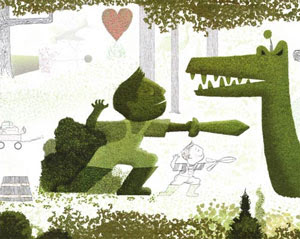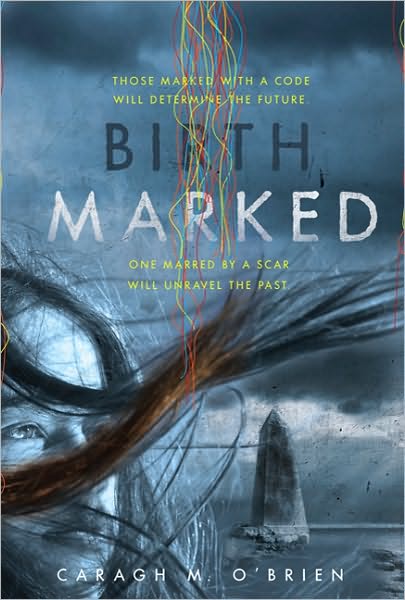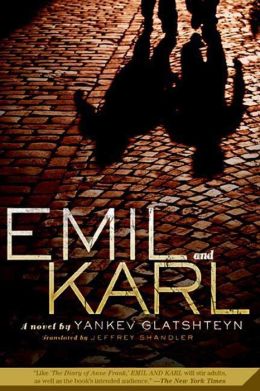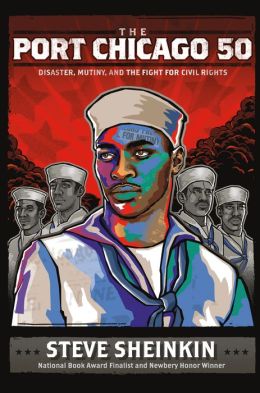new posts in all blogs
Viewing: Blog Posts Tagged with: Roaring Book Press, Most Recent at Top [Help]
Results 1 - 9 of 9
How to use this Page
You are viewing the most recent posts tagged with the words: Roaring Book Press in the JacketFlap blog reader. What is a tag? Think of a tag as a keyword or category label. Tags can both help you find posts on JacketFlap.com as well as provide an easy way for you to "remember" and classify posts for later recall. Try adding a tag yourself by clicking "Add a tag" below a post's header. Scroll down through the list of Recent Posts in the left column and click on a post title that sounds interesting. You can view all posts from a specific blog by clicking the Blog name in the right column, or you can click a 'More Posts from this Blog' link in any individual post.

By:
Becky Laney,
on 3/11/2015
Blog:
Becky's Book Reviews
(
Login to Add to MyJacketFlap)
JacketFlap tags:
J Fiction,
World War II,
Jewish,
Roaring Book Press,
MG Fiction,
1940,
review copy,
books reviewed in 2015,
books reread in 2015,
friendship,
2006,
Holocaust,
Add a tag
Emil and Karl. Yankev Glatshteyn. Translated from the Yiddish by Jeffrey Shandler. 1940/2006. Roaring Book Press. 208 pages. [Source: Review copy]
I love the idea of loving Emil and Karl by Yankev Glatshteyn. Emil and Karl was written in 1940 in Yiddish. It is set in Austria. It is the first--or at least among the very first--book written for children about the persecution Jews were experiencing from the Nazis.
Emil and Karl have always, always been best friends. Emil's Jewish. Karl's the son of socialists. Both are "orphans" in a way because of the Nazis. The book opens with intensity: readers first glimpse of Karl is haunting. Karl's mother has been taken away by the Nazis. He's witnessed this: not only the arrest, but the beating too. He's alone in the apartment, feeling very alone, very frightened, very worried. For they told him they'd be back to take him too. He doesn't know what to do next, where to go, who to trust. He decides to run to Emil's house. Emil's world has also been devastated within the past day or two. His father was taken and killed. His mother is grieving and shattered.
Karl and Emil are very much on their own it seems. The two stick together no matter what. They'll face danger and be put into difficult situations time and time again. There are many scenes that stay with you.
But while I find the premise of this one fascinating, it isn't the absolute best book about the holocaust. It may be among the first, but, that doesn't make it among the best of the best. Worth reading? I think so if you already have an interest in the subject. But if you only read one book on the subject, I'd have to recommend you go with another book.
© 2015 Becky Laney of
Becky's Book Reviews
The Graham Cracker Plot. Shelley Tougas. 2015. Roaring Brook Press. 288 pages. [Source: Library]
Most of The Graham Cracker Plot is a notebook or journal written to Judge Henry. The heroine, Daisy (Aurora Dawn) Bauer, though twelve, has gotten into trouble with the law. When the novel opens, Daisy is convinced of one thing. It is ALL Graham's fault. By the novel's close, will she have accepted responsibility for her role in 'The Graham Cracker' plot?
Will this review have spoilers? It depends. I tell no more than what the opening sentences reveal on the jacket flap. Actually, I reveal far less than the jacket flap does. In my opinion, this particular jacket flap reveals EVERY detail of the book. But the whole format of the book is an after-the-fact perspective of events.
So what is the Graham Cracker plot? Well. Daisy's father is in prison. She calls him the Chemist. (To my recollection, readers don't learn his real name.) She visits her father once a month with her grandmother. That is, she's supposed to be allowed to visit him once a month. Actually, Daisy loses her privilege of seeing him because of her behavior, her privileges are suspended for either three months or six. She loves the Chemist. And she hates to see him in prison. Not that she hates going there and seeing him. She feels she needs to see him in order to be okay. But she hates that he is in prison at all. She strongly feels that the Chemist is innocent and doesn't deserve to be in prison at all. The Graham Cracker plot is about breaking him out of prison and fleeing to Canada. It is the work primarily by two (troubled) children: Graham Hassler and Daisy herself. They get another person involved--Ashley. From start to finish, the Graham Cracker plot is a complete mess, a cringe-worthy failure of a plan. No matter what happens, however, Daisy and Graham want to carry on and keep on going.
Readers already know that the plan goes horribly wrong, and that Daisy is being 'punished' in some way for her involvement.
What I liked best about The Graham Cracker plot was the development of Daisy's character. The Daisy we meet at the beginning of the novel, is not quite the same Daisy readers are left with at the close. Some maturing has occurred. Which is a good thing, in my opinion. This one does have cringe-worthy moments. Moments where the characters are making horrible decisions--embarrassingly bad decisions.
© 2015 Becky Laney of
Becky's Book Reviews

by Philip Stead (Roaring Book Press, 2014)
This boy. This book.


We know Philip Stead can tell a story. Even his Number Five Bus interview series (with wife and creative partner Erin and ‘potentially interesting interactions with fellow book people’) is like a bowl of chicken noodle soup and a blanket.
Here’s what I love about this book.
That the copyright page tells us the art was made with pastels, oil paints, and pressed charcoal. Those things make your hands dirty and rub all the story off with it. There’s a feeling of grit there that I can’t quite figure out, but somehow these drawings feel loose and messy and full of both turbulence and elegance. The color is both rich and muted, deep and spare.

This red bird, that shows up on every single page. A constant companion to Sebastian’s wandering. A comfort.

That Philip Stead varies his compositions throughout, so that sometimes you are intimate with this cast, and sometimes you are pulling back for a wide shot of their world. That sometimes you are bobbing along with them and that sometimes you are floating free. That you feel the magnitude of this balloon trip, that you go with the wind too.

This leafless tree that gets the lumpiest-in-my-throat moment when it returns in glorious color. It was hard not to show you what I mean, but if you haven’t seen this part, then see this part. I won’t wreck the magic.

That the closest Sebastian comes to a smile is in sharing pickle sandwiches with his friends.

The way this milky gray fog is drawn. Moody and slightly scary and a barrier between the reader and the page. You can’t warn them about the pop because they couldn’t hear you through its thickness. They have to endure the danger.

That each character’s face is solemn and expressionless, but full of understanding. For each other, for pressing on, for seeing something. The tension there is the curiosity and the hope that they are finding comfort in their journey.


These sisters. Because.
###
This ramshackle roller coaster. Both “the most perfect roller coaster they would ever see” and chipped and faded and bent and broken and overrun with pigeons. And the pigeons, for where they go next.

That Sebastian thought to bring a boat and a ball of yarn.
And that I have a love/hate relationship with Caldecott speculation, but that big moon and patchwork balloon would look especially nice with a third round thing on the cover.

P.S. – Did I tell you about my spin on the Let’s Get Busy podcast with Matthew Winner and Kelly Light? That’s here if you want a listen. This book love guilt thing is no joke, because I keep thinking of other 2014 favorites that didn’t make our list, like this one. Huge thanks to book people for making great things. Don’t slow down. Also, here’s a super conversation between Philip and Jules at Seven Impossible Things Before Breakfast. More art! Not to miss.
The Port Chicago 50: Disaster, Mutiny, and the Fight for Civil Rights. Steve Sheinkin. 2014. Roaring Brook. 208 pages. [Source: Library]
Wow! What a book! Port Chicago 50 is a compelling nonfiction read. It is informative and detailed, but, it never felt like it was too much, like it was too-information-heavy. It was fascinating and at times shocking. It examines HOW African-Americans were treated in the navy during the second world war. It deals with prejudice and discrimination and injustice. Specifically it focuses on a select group of soldiers stationed at Port Chicago. The soldiers moving explosives from docks to ships were all African-Americans. These soldiers received no special training or instructions. It didn't take them long to figure out that disaster could come at any time, that every day came with big, big risks. Disaster did come. It was awful. It changed the survivors--haunted the survivors. So when these men are asked weeks later to go back to work with explosives, well, some decide to say no. The book is ultimately about 50 men who decided that they did not want to obey orders to load explosives. About the consequences of their actions--or inaction as the case may be. The men were charged with mutiny and put on trial. Would justice be served? Would they have a fair hearing?
The Port Chicago 50 is emotional and fascinating. It was a beautifully written story about the fight for justice and equality. It was everything a nonfiction book should be.
Definitely recommended.
© 2014 Becky Laney of
Becky's Book Reviews
The end-of-the-year lists have started cropping up. Just this past month The New York Times announced The 2011 Best Illustrated Children’s Books and Publisher's Weekly compiled the PW Best Books 2011: Children's Books. I like to keep a close eye on these early lists. It's possible the next Caldecott winner is among the titles mentioned. Don't believe me? Just look at a few of the lists from past few years and you'll see a connection.
Lane Smith's new picture book, Grandpa Green, made it onto both lists. His book gracefully tackles the subject of aging and intergenerational relationships. With unusually lush, green illustrations, it's simply a beautiful book.
 Grandpa Green
Grandpa Green by Lane Smith. Roaring Book Press (August 2011); ISBN 9781596436077; 32 pages
by Lane Smith. Roaring Book Press (August 2011); ISBN 9781596436077; 32 pages
Review Book Source: Copy from our local library
Grandpa Green captures important life moments in his garden, a horticultural memoir of sorts showing events and people from his past preserved in topiary. His great-grandson explores the lush trip down memory lane, stopping by all the carefully shaped trees and bushes and picking up the tools his great-grandfather has dropped along the way. A crying baby trimmed from a bush symbolizes Grandpa Green's birth, a carrot shaped topiary reminds everyone of his farming background, and a cannon and parachuters made out of plants represent his wartime experiences. "He used to remember everything. Now he's pretty old." Grandpa Green shapes his story plant by plant with his clippers, his most significant memories living on, flourishing and serving as a reminder, while new ones crop up along the way as he is assisted by his great-grandchild. Grandpa Green's legacy stands, ready to be passed down generation after generation.
Grandpa Green is the kind of book that affects people, young and old, in different ways. It's a poignant and interesting exploration of a life, and though Lane describes it as a fictional story, it seems deeply personal. Those with an elderly friend or family member or one diagnosed with Alzheimer’s disease will find it particularly touching. And even though the book tackles serious topics, there are plenty of touches of humor and playfulness that you'd expect from Smith like bunnies eating a topiary carrot and a reference to the Wizard of Oz. Both my daughter and son love to discuss all the detailed images found in the ink line drawings and painted foliage.

There's something magical about the crystal patterns on a frosted windowpane. The fern-like, random artwork by nature is one of the miracles of winter. Some say the art is the work of the legendary Jack Frost. We recently purchased and read a cute winter book about a boy who meets and plays outside with Jack Frost. (It's currently available as a bargain book on Amazon.)
 Here Comes Jack Frost
Here Comes Jack Frost by Kazuno Kohara. Roaring Brook Press (October 2009); ISBN: 9781596434424; 32 pages
by Kazuno Kohara. Roaring Brook Press (October 2009); ISBN: 9781596434424; 32 pages
Book Source: Our personal library
'"Who are you?" asked the boy.
"I'm Jack Frost!" replied the figure, and he ran into the woods.'
A lonely little boy sulks about inside his house during a cold, gray winter until one morning he notices patterns on the window. When he looks outside he sees a pointy white, elfish figure, the character responsible for the patterns. The boy befriends the figure, Jack Frost, and they play together all winter long, sledding, throwing snowballs and building snowmen against a brilliant blue sky.
Kazuno Kohara's stark white linocut images dance against the blue backgrounds, beautifully conveying the the wondrous bluish hues of winter. Even though she uses limited colors, Kohara still manages to add a special vivacity to her pictures. Kohara uses a similar illustration style in her Halloween themed book,
Ghosts in the House! While the newer book
, Here Comes Jack Frost isn't as humorous as the ghost book, it is a lovely, playful and fun winter read and a good, simple introduction to the character of Jack Frost.
❖❖❖❖❖❖ stArt Craft - Epson Salt Frost Paintings ❖❖❖❖❖❖Obviously some sort of printmaking craft would be the perfect activity to accompany this
Here Comes Jack Frost. But we've already tried two different printmaking techniques in January so we thought instead we'd pretend to be Jack Frost by making frost paintings using a special Epson salt solution.
I first saw instructions for the
Epson salt paint on Homemade Mamas. The recipe is simple - you combine 1/4 cup boiling water with 1/4 cup Epson salt. Then you stir until the crystals dissolve and let the solution cool slightly (a few minutes). The kids dip their paintbrush in the solution and cover the page with the liquid. As the paint dries, it crystallizes and forms interesting, sparkly patterns. Unplug Your Kids also offers a detailed and interesting post about
Salt Crystal Paint.
In our experience, Epson salt paint is a rather unpredictable product. Sometimes it dries and lovely crystalline patterns form and

By: Brimful Curiosities,
on 1/13/2011
Blog:
Brimful Curiosities
(
Login to Add to MyJacketFlap)
JacketFlap tags:
Book Review,
Picture Books,
Award Winner,
Animals,
Crafts,
2010,
Macmillan,
Roaring Book Press,
stART,
Book crafts,
Add a tag
Next time I'm sick I sure hope that a menagerie from the local zoo won't come knocking at my door. The last thing I want in bed with me is a tortoise, and I seriously doubt an elephant would fit in my bedroom. The thing is though, this whole scenario makes for a delightful picture book. Heard of A Sick Day for Amos McGee? Well, you should have, considering it was just chosen this week as the 2011 Caldecott Medal winner.
 A Sick Day for Amos McGee
A Sick Day for Amos McGee by Philip C. Stead, illustrated by Erin E. Stead. A Neal Porter Book/Roaring Book Press (May 2010); ISBN 9781596434028; 32 pages
by Philip C. Stead, illustrated by Erin E. Stead. A Neal Porter Book/Roaring Book Press (May 2010); ISBN 9781596434028; 32 pages
Book Source: Copy from public library
The humble Amos McGee lives in a simple, muted world and provides a welcoming contrast to the vibrant, glossy, eye-catching pages and bold characters so popular in today's children's literature. Amos, a faithful, elderly zookeeper, lovingly cares for his zoo animal friends day after day. He knows each and every animal personally, provides encouragement and helps them all with their problems. Then, one day, Amos spends a sick day at home. The elephant, tortoise, penguin, rhinoceros and owl immediately notice his absence and board the bus to cheer up their faithful friend. The book is illustrated by Erin E. Stead and written by her husband, Philip C. Stead.
It's such a lovely story -- so very heartwarming with a quiet humor. You can't help but smile while reading about Amos and his friends. And the illustrations are full of so many little details that, at first, we didn't even notice the little bird that tags along. And, do we ever adore the red and blue sock-footed, shy penguin and his bright red balloon! Erin Stead uses an interesting woodblock printing process for making her pictures. Even Amos' pajama stripes are lovingly printed in this manner. After she prints the shapes she draws in extra details with a pencil.
Really, I could go on and on about the illustrations, but for me, what really makes this book a winner is the main character, Amos. It's not always easy to find books for children that show elderly individuals in a positive light. Even though my daughter loves her great-grandparents and sees them often, she is still a little cautious and wary when around the elderly. Partly, I blame books and TV. Those mean, scary witches almost always are depicted as elderly, humped over women. But, here we have an amiable and tender man, Amos, who loves animals and wears bunny slippers. I've never seen a more lovable, elderly character in my life.
A Sick Day for Amos McGee deserves all the attention it has recently garnered. If you haven't picked up a copy yet, please do. You won't regret it.
Related links:
<
Marjorie and I at PaperTigers write the Books at Bedtime posts and these posts usually are about books appropriate for reading to children at bed time. However, I’m facing a bit of a dilemma having a 13 year old son and a 9 year old daughter. I no longer read to my son at bed time; he reads for himself and lately, his focus has been on comics and graphic novels. As a result, I’ve been getting hooked on graphic novels myself (although admittedly the fascination for this genre started for me when I was teen and had access to Japanese manga even though I couldn’t always read them very well) so I have decided to start reviewing graphic novels in future posts while still also doing the occasional Books at Bedtime post to cover those titles I read with my daughter.
However, as with many things in life, there are cross-overs and overlaps. While perusing the graphic novel shelf at the library, my daughter found one for herself and brought it over to me. The Boy, the Bear, The Baron, the Bard by Australian Gregory Rogers (Roaring Book Press, 2004) is a story set in Elizabethan England told entirely in images drawn by Rogers. You would think a book like this wouldn’t be appropriate for bedtime reading, but quite the contrary! My daughter, having perused the book, brought it to bed with her and asked if we could narrate the story together, playing the different parts of the characters depicted (which include, needless to say — the Bard Shakespeare, a baron, a bear and a boy.) This was a totally appropriate way to read this book, considering that it featured the famous playwright himself and the world of theatre. And we had fun, moreover, doing it!
Do you ever read graphic novels to your children at bedtime? Tell me if you do; I’d love to hear of your experiences. As children become more increasingly focused on the visual medium through the use of computers (we’re fast approaching the age of reading off our Kindles and Ipads to our children at night), reading graphic novels to our kids may well be the middle road of compromise!

Birthmarked. Caragh M. O'Brien. 2010. March 2010. Roaring Brook Press. 368 pages.
In the dim hovel, the mother clenched her body into one final, straining push, and the baby slithered out into Gaia's ready hands.
Gaia is a young woman training to be a midwife just like her mother before her. When Birthmarked opens, Gaia is attending her first birth. For the first time, she'll be the midwife--not just the apprentice. What Gaia doesn't know is that at the very time she's attending this birth, her parents are being arrested by the Enclave. When she returns home, when she learns this truth, her life is forever changed.
Birthmarked is an emotional read. Or at least I found it to be so! In the first chapter, Gaia helps a woman deliver a baby--a girl--only to take that baby away from its distraught mother. This newborn babe will never know its mother, for she is one of the babies being "advanced" that month. Gaia sees this as just the way things are. Some babies are advanced, others aren't. It's just a given that a couple will lose some of its children to the Enclave. They should just be grateful, right? Because life in the Enclave is better than life on the outside, right? That's how it appears on the Tvaltar anyway. And what reason would the Enclave have for lying?
After Gaia learns of the arrest, she's in a vulnerable position. She's forced into questioning everything. She has to reflect on her life--on her past, on everything she knows about her parents--and to begin contemplating her future. Should she continue to serve the Enclave? Should she continue to hand over babies even if the monthly quota goes up? Should she cooperate with the Enclave? Even if it means incriminating her parents?
I am fascinated by futuristic books, dystopias especially. I enjoyed this one. I would recommend it!
Other reviews: Presenting Lenore, There's A Book, What Book Is That?, Reading Rocks, Steph Su Reads, The Reading Zone, Kids Lit, One Librarian's Book Reviews, Bloggin' Bout Books.
© Becky Laney of Becky's Book Reviews


























Wow! This looks like a wonderful book!
We loved this one too. I think it is able to speak to different audiences on different levels. Plus, it's different than anything else that is out there. I think it helps kids to think outside the box... I mean, who makes a timeline out of topiaries? That's cool!
I read another review of this book and thought that it sounds very interesting. Thanks for joining WMCIR!